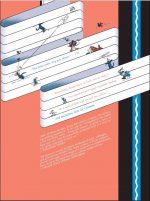

By George Herriman, edited by Bill Blackbeard & Derya Ataker (Fantagraphics Books)
ISBN: 978-1-56097-594-6
The cartoon strip starring Krazy Kat is arguably the pinnacle of graphic narrative innovation; a singular and hugely influential body of work which shaped the early days of the comics industry and became an undisputed treasure of world literature.
Krazy and Ignatz, as it is now dubbed for these glorious commemorative tomes from Fantagraphics, is a creation which must be appreciated on its own terms. The strip developed a unique language – at once both visual and verbal – and dealt with the immeasurable variety of human experience, foibles and peccadilloes with unfaltering warmth and understanding without ever offending anybody.
Sadly, however, it baffled far more than a few…
It was never a strip for dull, slow or unimaginative people who simply won’t or can’t appreciate the complex multi-layered verbal and pictorial whimsy, absurdist philosophy or seamless blending of sardonic slapstick with arcane joshing. It is still the closest thing to pure poesy that narrative art has ever produced.
Herriman was already a successful cartoonist and journalist in 1913 when a cat and mouse who had been cropping up in his outrageous domestic comedy strip The Dingbat Family/The Family Upstairs graduated to their own feature. Krazy Kat debuted in William Randolph Hearst’s New York Evening Journal on Oct 28th 1913 and – largely by dint of the publishing magnate’s overpowering direct influence and interference – gradually spread throughout his vast stable of papers.
Although Hearst and a host of the period’s artistic and literary intelligentsia (notably – but not exclusively – e.e. Cummings, Frank Capra, John Alden Carpenter, Gilbert Seldes, Willem de Kooning, H.L. Mencken and – latterly – Jack Kerouac) all adored the strip, many local and regional editors did not; taking every potentially career-ending opportunity to drop it from the comics section.
Eventually the feature found a home and safe haven in the Arts and Drama section of Hearst’s papers. Protected there by the publisher’s heavy-handed patronage, the Kat flourished unharmed by editorial interference and fashion, running generally unmolested until Herriman’s death in April 1944.
The basic premise is simple: Krazy is an effeminate, dreamy, sensitive and romantic feline of indeterminate gender hopelessly in love with Ignatz Mouse: rude crude, brutal, mendacious and thoroughly scurrilous.
Ignatz is a true unreconstructed male; drinking, stealing, fighting, conniving, constantly neglecting his wife and children and always responding to Krazy’s genteel advances by clobbering the Kat with a well-aimed brick (obtained singly or in bulk from noted local brick-maker Kolin Kelly) which the smitten kitten invariably misidentifies as tokens of equally recondite affection.
The third crucial element completing an anthropomorphic eternal triangle is lawman Offissa Bull Pupp, who is completely besotted with Krazy, professionally aware of the Mouse’s true nature, yet hamstrung – by his own amorous timidity and sense of honour – from removing his devilish rival for the foolish feline’s affections.
Krazy is, of course, blithely oblivious to Pupp’s dilemma…
Also populating the ever-mutable stage are a stunning supporting cast of inspired bit players such as dreaded deliverer of unplanned, and generally unwanted, babies Joe Stork; hobo Bum Bill Bee, unsavoury conman and trickster Don Kiyoti, busybody Pauline Parrot, self-aggrandizing Walter Cephus Austridge, inscrutable, barely intelligible Chinese mallard Mock Duck, dozy Joe Turtil and a host of other audacious characters all equally capable of stealing the limelight and even supporting their own features.
The exotic, quixotic episodes occur in and around the Painted Desert environs of Coconino (based on the artist’s vacation retreat in Coconino County, Arizona) where surreal playfulness and the fluid ambiguity of the flora and landscape are perhaps the most important member of the cast.
The strips themselves are a masterful mélange of unique experimental art, wildly expressionistic and strongly referencing Navajo art forms whilst graphically utilising sheer unbridled imagination and delightfully evocative lettering and language: alliterative, phonetically and even onomatopoeically joyous with a compelling musical force (“Soff, soff brizzâ€, “l’il dahlink†or “Ignatz, ware four is thou at Ignatz??â€).
Yet for all that, the adventures are poetic, satirical, timely, timeless, bittersweet, self-referential, fourth-wall bending, eerily idiosyncratic, astonishingly hilarious escapades encompassing every aspect of humour from painfully punning shaggy dog stories to riotous, violent slapstick.
Sometimes Herriman even eschewed his mystical mumblings and arcane argots for the simply sublime grace of a supremely entertaining silent gag in the manner of his beloved Keystone Cops…
There’s been a wealth of Krazy Kat collections since the late 1970s when the strip was first rediscovered by a better-educated, open-minded and far more accepting generation. This delirious tome, covering all the new Sunday Page material from 1931-1932 in a comfortably hefty (231 x 15 x 305 mm) softcover edition – and also available as a merely magical digital edition – is another monochrome masterpiece expansively offers a beguiling extra treat by reprinting a selection of Herriman’s Krazy Kat Daily strips too.
Informative context, background and possible explanations are, as always, delivered by the much-missed Bill Blackbeard in another effusive exploration of Herriman’s earlier cartoon characters via his picture-packed Introductory essay ‘The Baron and the Duke: Other Great Stuff Before the Bricks Zipped’ with examples of prototypical charming social parasite Baron Mooch and anthropomorphic avian aristocrat and sporting good egg Gooseberry Sprig, the Duck Duke.
On to the strips then: within this compelling compendium of incessant passions thwarted in another land and time, the torrid triangular drama plays out as winningly as ever, but with a few new faces popping up to contribute to the insular insanity and well-cloaked social satire…
We open in the depths of February following a spate of (not-included) re-runs, with Krazy konsulting palm reader and “mystic of Mysore†Moul Azziz Khandi who advocates the spreading of a wild oat or two before it’s too late. Sadly, with someone as simplistic and literal-minded as the Kat, that’s a recipe for disaster when Offisa Pupp and Ignatz spot the shenanigans…
As always the mouse’s continual search for his ammunition of choice leads to many brick-based gags and his occasional fleecing by Coconino’s (occasionally “Kokoninoâ€) copious coterie of confidence tricksters – a scurrilous sub-population which seems to grow weekly…
Of course, the mouse is a man who enjoys revenge served hot, cold or late…
Amongst the new arrivals is an extremely bellicose elephant who never forgets the slightest slight and harbours no love for the Law or its agents, and greater use of ideal comedy maguffin Joe Stork, whose delivery of (generally unwanted) babies still brings dread responsibility and smug schadenfreude in equal amounts to all denizens of the county.
As ever there is a solid dependence on the strange landscapes and eccentric flora for humorous inspiration and bizarre weather plays a greater part in inducing anxiety and bewilderment.
One happy circumstance is the growing use of the county lock-up as the escalating slapstick silliness more often concludes with Ignatz incarcerated. Naturally that just means the mean Mus Musculus (look it up if you must) magnifying his malevolent efforts; even regularly taking to the air in a series of aeronautical escapades…
A war of civic status breaks out between Coconino communities Shonto and Oljeto as both hamlets race to increase their populations by inviting immigrant rabbits and “Ginny Piggs†to settle there. It all gets very crowded after prankish Ignatz gets Joe Stork involved too…
Krazy has not surrendered that dream of a singing career, much to everybody’s dismay, and an (initially) welcome chaotic distraction arrives in the temporarily frozen form of Mr. Eale Ektrik Eel of Red Lake, before the Kacophonous Kitty becomes bemused by a flurry of unseasonal, geographically-challenged Coconut incursions…
The year 1932 started cold and wet but still offered more of the same before providing a new fascination for Krazy when commercial radio broadcasting began in Coconino. This talking point was quickly eclipsed by the introduction of a tumultuous cast addition: a distant relative and his lonely domicile: Uncle Tomm Katt and his ramshackle Cabin.
The venerable gent was no fool, hated cops and mice equally and dealt harshly with any fool dumb enough to heft bricks in his vicinity. He was to be only an occasional player on the Sunday pages but found his true home in the knockabout rowdiness of the Krazy Kat Dailies…
Herriman was a master of the comic strip and fully grasped the fundamental differences between the demands of short sharp bursts of fun needed for the Monday to Saturday strip and the vastly magnified scope afforded him by a whole page every sabbath. Here to close this volume is incorporated a run of Dailies which perfectly highlight the contrasts and similarities in ‘The Daily Krazy Kat Strip, 1931’ culled from the twenty or so papers which willingly ran the controversial periodical feature.
The 4 panel episodes span January 26th through April 4th; displaying less high-blown whimsy but a solid eye for a great visual gags and incorporating Herriman’s love of wild wordplay and slapstick cinema, with a smaller core cast playing fast and loose with sense and sensibilities…
Supplementing the cartoon gold is another erudite and instructional ‘Ignatz Mouse Debaffler Page’, providing ‘Komments on Mysteries of the Master’s Drawing Mesa’ through pertinent facts, snippets of contextual history and necessary notes for the young and potentially perplexed.
Herriman’s epochal classic is a phenomenal achievement: in all the arenas of Art and Literature there has never been anything like these comic strips which have shaped our industry and creators, and inspired auteurs in fields as disparate as prose fiction, film, dance, animation and music, whilst delivering delight and delectation to generations of wonder-starved fans.
If, however, you are one of Them and not Us, or if you actually haven’t experienced the gleeful graphic assault on the sensorium, mental equilibrium and emotional lexicon carefully thrown together by George Herriman from the dawn of the 20th century until the dog days of World War II, this astounding compendium is a most accessible way to do so.
© 2004, 2015 Fantagraphics Books. All rights reserved.
